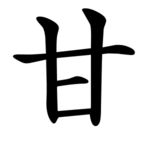Radical 99
 From Wikipedia the free encyclopedia
From Wikipedia the free encyclopedia
| 甘 | ||
|---|---|---|
| ||
| 甘 (U+7518) "sweet" | ||
| Pronunciations | ||
| Pinyin: | gān | |
| Bopomofo: | ㄍㄢ | |
| Gwoyeu Romatzyh: | gan | |
| Wade–Giles: | kan1 | |
| Cantonese Yale: | gām | |
| Jyutping: | gam1 | |
| Japanese Kana: | カン kan (on'yomi) あま-い ama-i (kun'yomi) | |
| Sino-Korean: | 감 gam | |
| Names | ||
| Japanese name(s): | 甘/あまい amai 甘/かん kan | |
| Hangul: | 달 dal | |
| Stroke order animation | ||
 | ||
Radical 99 or radical sweet (甘部) meaning "sweet" is one of the 23 Kangxi radicals (214 radicals in total) composed of 5 strokes.
In the Kangxi Dictionary, there are 22 characters (out of 49,030) to be found under this radical.
甘 is also the 101st indexing component in the Table of Indexing Chinese Character Components predominantly adopted by Simplified Chinese dictionaries published in mainland China.
Evolution
[edit]- Oracle bone script character
- Bronze script character
- Large seal script character
- Small seal script character
Derived characters
[edit]| Strokes | Characters |
|---|---|
| +0 | 甘 |
| +3 | 𤮾 𤮿 甙 |
| +4 | 甚 |
| +5 | 㽍 |
| +6 | 甛 甜 |
| +8 | 㽎 甝 甞 (=嘗 -> 口) |
| +9 | 㽏 |
| +10 | 㽐 𤯊 |
| +12 | 㽑 |
| +17 | 𤯑 |
Sinogram
[edit]甘 is a Jōyō kanji, or a kanji used in writing the Japanese language.[1] It is a secondary school kanji.[2]
See also
[edit]References
[edit]- ^ "Jōyō Kanji Hyō" 常用漢字表 [List of Joyo Kanji] (PDF) (in Japanese). Agency of Cultural Affairs, Government of Japan. Retrieved November 7, 2018.
- ^ "KANJI-Link". www.kanji-link.com. Retrieved 2023-06-02.
Literature
[edit]- Fazzioli, Edoardo (1987). Chinese calligraphy : from pictograph to ideogram : the history of 214 essential Chinese/Japanese characters. calligraphy by Rebecca Hon Ko. New York: Abbeville Press. ISBN 0-89659-774-1.
- Lunde, Ken (Jan 5, 2009). "Appendix J: Japanese Character Sets" (PDF). CJKV Information Processing: Chinese, Japanese, Korean & Vietnamese Computing (Second ed.). Sebastopol, Calif.: O'Reilly Media. ISBN 978-0-596-51447-1.



